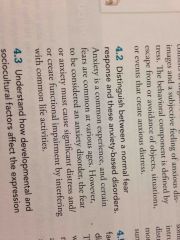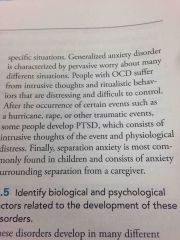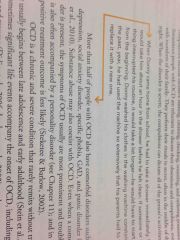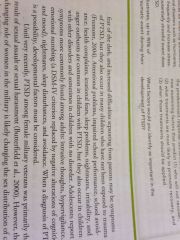![]()
![]()
![]()
Use LEFT and RIGHT arrow keys to navigate between flashcards;
Use UP and DOWN arrow keys to flip the card;
H to show hint;
A reads text to speech;
36 Cards in this Set
- Front
- Back
|
A common emotion that is characterized by physical symptoms and thoughts or worries that something bad will happen |
Anxiety |
|
|
Part of your brain that is responsible for recognizing the threatening situations and coordinating your response send message to your adrenaline glands to receive the hormone adrenaline |
Hypothalamus |
|
|
Two parts body nervous system consist of |
Central nervous system(brain and spinal cord) Peripheral nervous system(other nerves in body) |
|
|
Somatic sensory and autonomic nervous(involuntary movements) come from peripheral |
Parasympathetic nervous and sympathetic nervous come from autonomic |
|
|
Fight or flight |
Associated with fear Allows you to use all available resources to escape from a threatening situation |
|
|
An abrupt surge of intense fear or intense discomfort that reaches a peak within minutes and is accompanied by four or more physical symptoms |
Panic attack |
|
|
Headaches and stomache are common in |
Children Older children report physical distress |
|
|
Physical symptoms of anxiety include |
Blushing buzzing ringing in ear Muscle tension Irritability Fatigue Gastrointestinal |
|
|
Specific thoughts, ideas, images, or impulses |
Cognitive symptom |
|

Three components of anxiety |
Physical symptoms Cognitions/Subjective distress Escape or avoidance behavior |
|
|
Thoughts occur when |
See object that's feared Spontaneously |
|
|
Worry (another type of cognitive symptom) |
Negative apprehensive expectations about the future that are considered to be unreasonable in light of actual situation |
|
|
Among children do not report worry that is common among adults |
Meta cognition When become older able to recognize and report own thoughts |
|
|
Avoid fear or run away from it Overdoing certain behaviors (germs over wash) |
Behavioral symptom |
|
|
Behavioral symptom in childen |
Play sick Cry Clingy Throw a tantrum Become disobedience |
|
|
Escape or avoidance behavior |
Brings temporary relief from distress |
|
|
Two types of panic attacks |
Excepted panic attacks (occur in response to situational cue or trigger / anticipation of feared
Unexpected panic attacks (considered a false alarm no object event or situation appears to precipitate the attack) |
|
|
Is marked or intense fear or anxiety that occurs upon exposure to or in anticipation of a broad range of situations |
Agoraphobia Many develop after panic disorder |
|
|
Panic disorder and agoraphobia |
Rare in young children and only slightly common among adolescents Begins in early adulthood Panic disorder is mot common in adults |
|
|
Panic disorder |
At least one panic attack and worries about having more attacks May call doctor after every attack |
|
|
Women are more likely to experience panic attacks and disorders than men and variation across cultural groups |
At aqua de nervous is Among latinos |
|
|
Women are more likely to experience panic attacks and disorders than men and variation across cultural groups I |
At aqua de nervous is Among latinos |
|
|
Excessive anxiety and worry occurring more days than not and lasting at least 6months
Worry about future financial past
Children worry about performance or ability More in adults than children |
Generalized anxiety disorder Worry may be uncontrollable with physical symptoms |
|
|
A marked fear of social situations which may invoke scrunity by others
Situations that cause distress are speaking eating drinking or writing in front of others |
Social anxiety disorder |
|
|
Fear about specific object or situation leads to significant disruption in daily functioning |
Specific phobia |
|
|
Demographic factors as gender race ethnicity age and socioeconomic status also influence the expression of anxiety |
Women report at a higher rate than men and boys |
|

Front (Term) |
G |
|
|
Mostly affect preadolescent children A developmentally inappropriate and excessive anxiety concerning separation from someone to whom child is emotionally attached |
Separation anxiety disorder Get over I. Short period of time Girls more likely than boys Racial equal |
|
|
Consist if persistent thoughts obsessions with compulsions behavior that are extensive time consuming and distressful |
Obsessive compulsive disorder Recognize impulse product of own mind
Obsession are the crazy thoughts
Compulsions are repetitive behavior |
|
|
Consist if persistent thoughts obsessions with compulsions behavior that are extensive time consuming and distressful |
Obsessive compulsive disorder Recognize impulse product of own mind
Obsession are the crazy thoughts
Compulsions are repetitive behavior |
|

Front (Term) |
Begins late adolescence early adulthood
Small percentage have obsession without compulsions |
|
|
Tramatic event such as the military combat rape assault of the series injury or violent death of another person may suffer in the psychological and physical logical reaction |
Post traumatic stress disorder |
|
|
Post traumatic stress disorder Inability to feel emotions as joy surprise or you feel detached from people and are very hyper arousal of surrounding and difficult to sleep and avoidance of objects and situations |
The presence of emotions such as fear and helplessness bullhorn other emotions as guilt shame intrusion is assistant symptom thoughts dreams me a current fact is if it's happening again |
|

|
Children Very prevalent in African American children Then Hispanic too |
|
|
Anxiety and stress can alter brain chemistry and some brain structures |
This stuff is heritability |
|
|
Front (Term) |
X |

